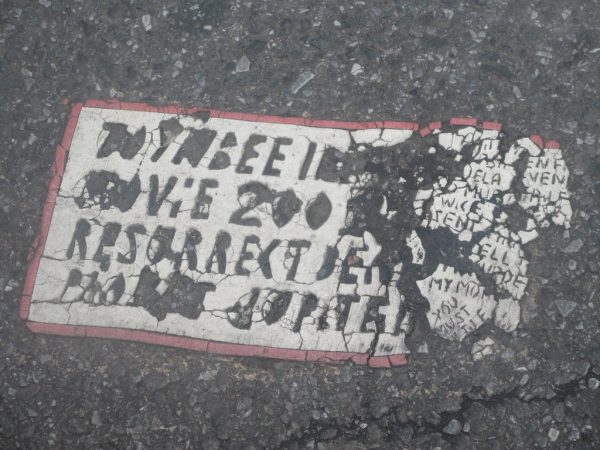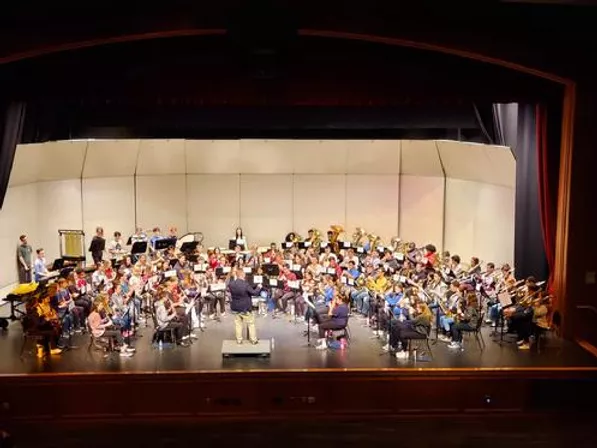Toynbee Tiles: A Case of Suspicious Asphalt
Bumpy and unpaved roads have the potential to be extremely frustrating. With a couple of potholes, tires are in constant danger of a single prod expelling air at an alarming rate. The road can also be littered with objects that can catch an unsuspecting driver off guard. Foreign parts, weird unidentifiable garbage bags, and other nonsensical items cause swerves and interruptions to tunnel vision. However, the asphalt installations that will be discussed in this article caused more alarm than that weird plastic bag in the middle of the street.
The Toynbee Tiles have left civilians and experts puzzled. These strange engravings have popped up across multiple cities on the East Coast, but they are mainly concentrated in Philadelphia. The inscription reads “TOYNBEE IDEA IN MOVIE 2001 RESURRECT DEAD PLANET JUPITER” with little context. These began in the aforementioned Philadelphia in the 1980s but eventually spread to NYC, Boston, Chicago, Pittsburgh, and many others. There is little to no context or evidence surrounding the tiles, so they could mean practically anything.
JUPITER” with little context. These began in the aforementioned Philadelphia in the 1980s but eventually spread to NYC, Boston, Chicago, Pittsburgh, and many others. There is little to no context or evidence surrounding the tiles, so they could mean practically anything.
The actual material they are made of has been hotly debated. The main consensus, though, is that the tiles, covered in tar paper, were littered from cars during the summer, and the heat allowed them to fuse with the asphalt as well as the feet that walk over the city sidewalks every day. They resemble a license plate in size and usually feature multiple different colors that make them a very obvious sight on the side of the road. Some even feature accompanying images, like one with a depiction of a car driving towards a bustling city.
The text of the plate has plenty of allusions and references. The “MOVIE 2001” refers to Stanley Kubrick’s 2001: A Space Odyssey. There are plenty of intense themes, including space exploration and artificial intelligence. The characters embark on a mission to Jupiter, which is likely where that detail is sourced from. The word “TOYNBEE” could also be a short story by Ray Bradbury or the man Arnold Joseph Toynbee, who claimed that myths were just as valuable as facts. He was a historian who investigated the rise and fall of countless ancient civilizations. From 1934 to 1961, his 12-volume A Study of History dissected these collapses.
One of the only lines drawn between the tiles and real events is an organization led by James Morasco called the Minority Association, and the people involved wanted to colonize Jupiter by sending bodies to the planet and reviving them. In fact, Morasco said he was inspired to carry out his work by Arnold Toynbee. Another connected name was Severino Verna, who supposedly had a miniature version of the tiles surrounding his home. Despite this, no concrete evidence has been found, so conclusions cannot be drawn between them.
 The number of Toynbee Tiles added to the streets of eastern cities was on the decline, but after a documentary titled Resurrect Dead: The Mystery of The Toynbee Tiles, many more began to pop up not only in the United States but also in parts of South America like Santiago, Chile and Buenos Aires, Argentina. They also began to move west, being found as far as Kansas City, Missouri. These plates also had new varieties of text, which read “HOUSE OF HADES, THE RESURRECTION OF TOYNBEE’S IDEA IN SOCIETY 2012” and “HOUSE OF HADES ONE MAN VERSUS AMERICAN MEDIA IN SOCIETY 2017.” These could have been the same individual or group behind the originals, but they were likely copycats swept up in the thrill.
The number of Toynbee Tiles added to the streets of eastern cities was on the decline, but after a documentary titled Resurrect Dead: The Mystery of The Toynbee Tiles, many more began to pop up not only in the United States but also in parts of South America like Santiago, Chile and Buenos Aires, Argentina. They also began to move west, being found as far as Kansas City, Missouri. These plates also had new varieties of text, which read “HOUSE OF HADES, THE RESURRECTION OF TOYNBEE’S IDEA IN SOCIETY 2012” and “HOUSE OF HADES ONE MAN VERSUS AMERICAN MEDIA IN SOCIETY 2017.” These could have been the same individual or group behind the originals, but they were likely copycats swept up in the thrill.
With the copycats popping up in various cities like San Francisco, Portland, Roswell, Detroit, and Tulsa, the likelihood that the original creator was not behind these works of mysterious art is very high. The increase in these scenarios makes discerning the true purpose behind the originals a bit more difficult. Despite this chaos, the Toynbee Tiles have actually done some good. Justin Duerr, an aspiring Philadelphian artist and musician, took the Toynbee Tiles as a sign to continue his work in the outermost reaches of the city’s art scene.
The Toynbee signs grew past the tiles scattered across city streets. In fact, TV signals across Philadelphia had been interrupted with a Toynbee-related signal, and some radio addresses had even been connected to the occurrence. Regardless, the Toynbee Tiles have remained a mystery for decades, and with all the attention they have received, it might be impossible to actually discern the answer. However, they still remain a landmark of the 1980s and a testament to one of Kubrick’s greatest films.













































